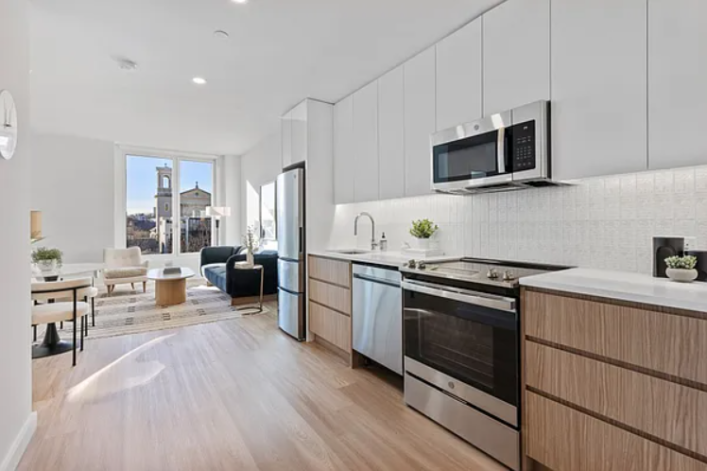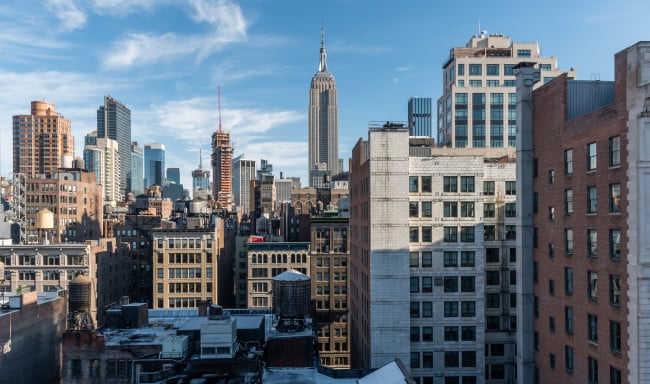Demand for new rentals near subway stops in the outer boroughs spurs higher rents
- Rents are priced higher than the market average at many new developments
- Median one-bedroom rent near one Clinton Hill station increased by 20.7 percent
- Subway ridership passed 4 million in late April, a level not seen since March 2020

A one bedroom at new luxury rental development 540 Waverly in Clinton Hill is on the market for $4,000.
What happens when lots of New York City renters head to the same outer borough areas in search of cheaper new construction? You probably know where this is going: Rents rise because of increased demand.
Brand new rental developments are luring renters to far-flung parts of the outer boroughs, according to RentHop’s annual Subway Stop Report, which looks at how much a renter can save on a one bedroom by living far from Manhattan or near a different subway station.
The rental listing site’s report notes that new rental developments, where units are typically priced above average market rates and are often situated close to subway stations to attract renters, drove up rents particularly in Brooklyn and Queens neighborhoods.
Rent-stabilized units at new developments
A percentage of these new developments are typically rent-stabilized units, which offer some opportunities for renters who need more affordable housing. New buildings that received a tax exemption have rent-stabilized apartments available through the city's Housing Lottery.
"New York City has seen so many new developments in recent years take advantage of various incentives for including affordable housing," says Lee Lin, CEO and co-founder of RentHop.
But the end result "is a nice, new building packed with amenities is going to drive prices higher. Maybe a few people wind up winning the lottery, but we've seen neighborhoods completely change after a few luxury high rises came into the picture. It will be interesting to see whether the trend continues as tax and interest rate policies become more restrictive," Lin says.
Subway ridership nearly back to pre-Covid levels
Also rising is subway ridership, which passed 4 million in late April, a level not seen since March 2020 when the pandemic struck the city.
RentHop finds that the current median rent for a NYC one bedroom is $4,250, which is 8.17 percent higher than a year ago, and that areas around 95 percent of MTA subway stops saw year-over-year rent increases.
In Clinton Hill, new rental buildings such as 545 Vanderbilt Ave., 1010 Pacific St., and 540 Waverly Ave. caused the median rent for that locale to increase significantly—these buildings have a mix of market-rate and rent-stabilized units. The median one-bedroom rent for buildings around Clinton—Washington stop for the A and C trains increased by 20.7 percent to $3,500, as per the report. A one bedroom at 540 Waverly Ave. is asking $4,000 a month.
In Queens, the new development One Archer at 92-27 160th St. increased the median rent for one-bedroom units around Jamaica Center—Parsons/Archer station, where you can catch the E, J, and Z trains, by 20.8 percent to $2,426. One-bedroom units start at $2,650 at One Archer.
The report notes that this year’s rent increase was less steep than in 2022, which saw a huge leap from the Covid discounts renters landed in the prior year. This year, areas around 23 stops, or 4.9 percent, decreased in rent, including Gravesend, Battery Park, and the Financial District, where rents dropped slightly. (This may be temporary, for example luxury development 2300 Cropsey Ave. in Gravesend, which is nearing completion, will add 154 new apartments to the market.
Manhattan rents for apartments near subway stops did not drastically increase from last year and areas around multiple stops in the Financial District saw rents drop, including Wall Street (2, 3 trains, -1.1 percent); Fulton Street (A, C, J, and Z, -1.0 percent); and Rector Street (R,W trains, -1.4 percent)—but it’s important to point out the Financial District is one of the city’s most expensive neighborhoods for renters.
You Might Also Like































